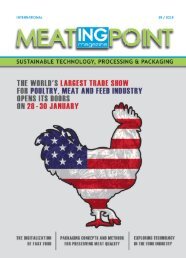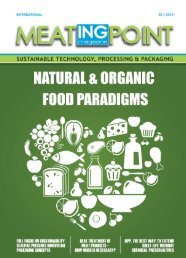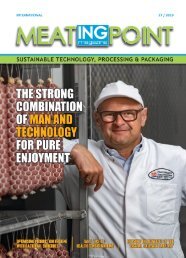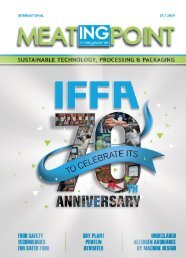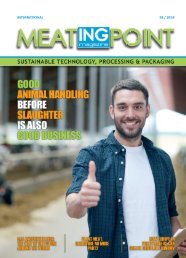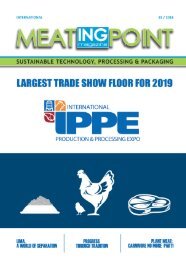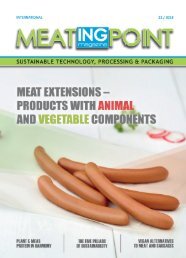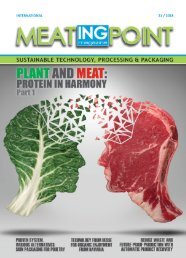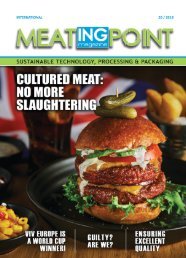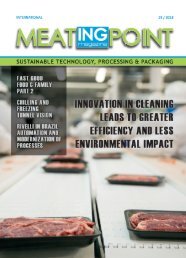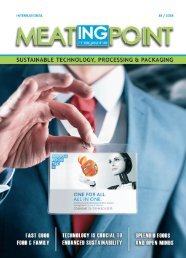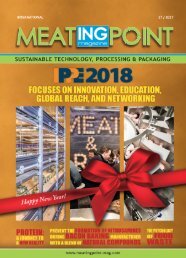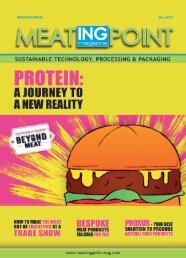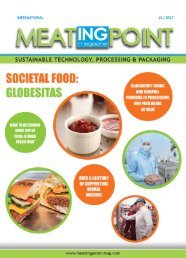MEATing POINT Magazine: #08/ 2016
You also want an ePaper? Increase the reach of your titles
YUMPU automatically turns print PDFs into web optimized ePapers that Google loves.
FREEZING<br />
Stability of pork during<br />
frozen storage<br />
by Lene Meinert and Hardy Christensen, Danish Meat Research Institute, Denmark<br />
Freezing is a well-known and widespread<br />
preservation method, prolonging the<br />
shelf life of meat and many other<br />
food items. Freezing is popular, as it allows<br />
meat to keep a close-to-fresh quality for a<br />
long time, and it also allows long distance<br />
transports. However, depending on the<br />
time and temperature combinations<br />
during frozen storage, changes in meat<br />
quality can indeed occur. These changes<br />
include lipid oxidation, a major cause<br />
of deterioration of meat generating the<br />
undesired rancid flavour. It is important<br />
to note that freezing, which we use for<br />
food storage and distribution today, is<br />
not an infinite preservation method and<br />
quality reductions, made before freezing,<br />
do not disappear.<br />
The composition of pork<br />
In order to understand which factors<br />
may affect the stability of pork during<br />
frozen storage, it is important to look at<br />
the composition of pork. Pork consists<br />
primarily of water, protein and fat, the<br />
proportion of the three vary greatly<br />
between the different cuts, some being<br />
more fatty e.g. pork belly than others<br />
e.g. pork loin. The composition of fat,<br />
or fat quality, has a huge influence<br />
on shelf life and thereby also storage<br />
time, as the unsaturated fat content<br />
is prone to oxidation. Furthermore,<br />
pork also contains components that<br />
may promote oxidation such as iron.<br />
Finally, the amount of water influences<br />
the freezing process, as high water<br />
contents require increased freezing times.<br />
The freezing process<br />
The freezing process is influenced by several<br />
factors including 1) the size of the meat cuts,<br />
2) temperature differences between the meat<br />
surface and meat core, and as previously<br />
mentioned, 3) the content of water in the<br />
meat. During the freezing process, the water<br />
will gradually change into ice. See figure 1<br />
Figure - 1 The freezing process in a piece of meat.<br />
Figure1 - 2 Temperature curves for the freezing of<br />
pork loins using three different freezing processes.<br />
Figure - 3 Lipid oxidation measured as TBARS in<br />
pork patties as a function of storage time<br />
(Hansen et al., 2004).<br />
The speed by which the meat is frozen is<br />
closely related to the freezing method used.<br />
An example of this is the time used for<br />
reaching -18°C. One of the fastest methods<br />
is freezing with cryogen, in two hours<br />
a pork loin of approx. 3 kg will reach<br />
-18°C. In comparison, using air blast<br />
will take 17 h to reach -18°C, and still<br />
air in a freeze room will take 24 h. That<br />
is, if the loins are not packed together<br />
in cardboard boxes and stacked on<br />
pallets – then the time to reach -18°C<br />
is much longer with worst case scenario<br />
of several days before all meat cuts<br />
are frozen.<br />
Another example of an industrialised<br />
and fast method for freezing meat<br />
is the impingement freezer, in which<br />
meat cuts are placed individually on<br />
a belt conveyer transported through a<br />
tunnel with air blast. The meat is frozen<br />
within a short time e.g. 1 h depending<br />
on the size of the individual cuts.<br />
Effects on shelf life during frozen<br />
storage<br />
Generally, shelf life of meat is limited<br />
by growth of bacteria and chemical<br />
changes in the meat. In frozen<br />
meat, it is the chemical changes that<br />
prevail. However, chemical reactions<br />
are slowed down closely related to<br />
the lowering of the temperature.<br />
Furthermore, the oxidation reactions<br />
are slowed or completely inhibited<br />
by the absence of oxygen meaning<br />
that the packaging materials also<br />
influence the shelf life.<br />
Most bacteria do not grow well at<br />
temperatures below 0°C, and microbial<br />
growth at freezing temperatures is<br />
more commonly related to molds<br />
and yeasts. Some processed products<br />
e.g. bacon are more likely to support<br />
microbial growth below zero degrees, as<br />
these products might contain so-called<br />
cryoprotectants, e.g. sugar compounds,<br />
that depress the freezing point of water<br />
(Jay, 2000). It is important to note, that<br />
if sugar is added to bacon it is because<br />
issue 8 | www.meatingpoint-mag.com<br />
39




